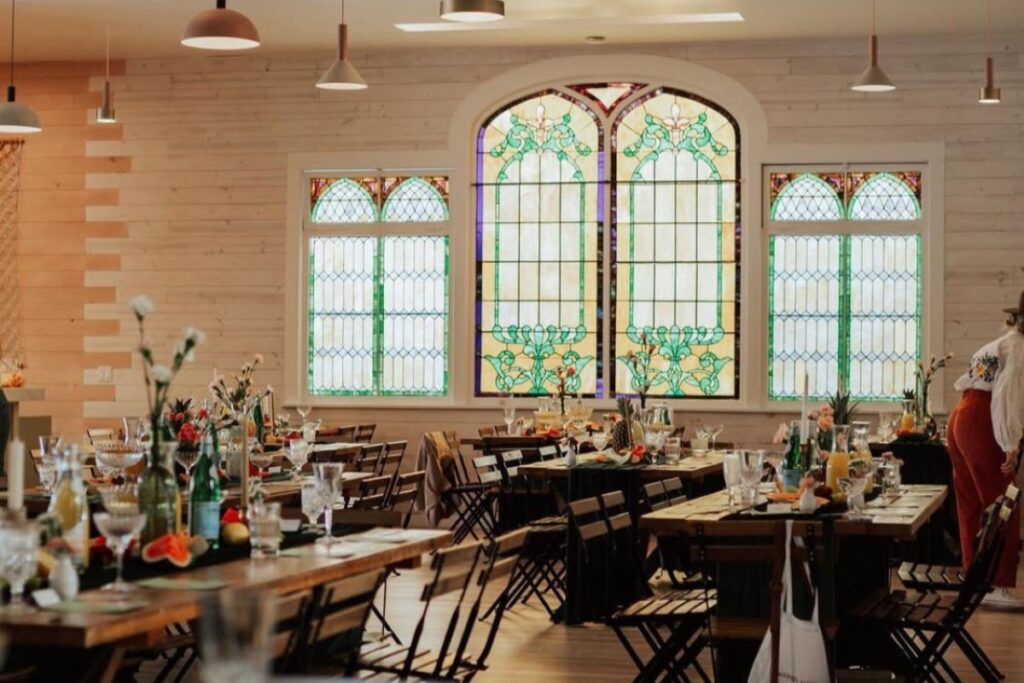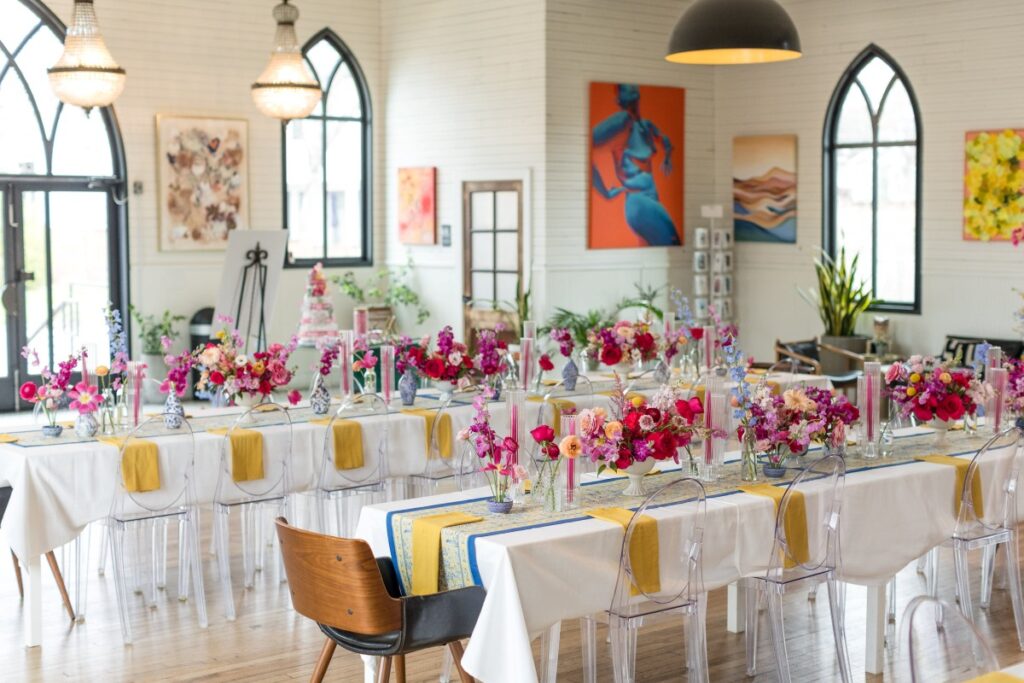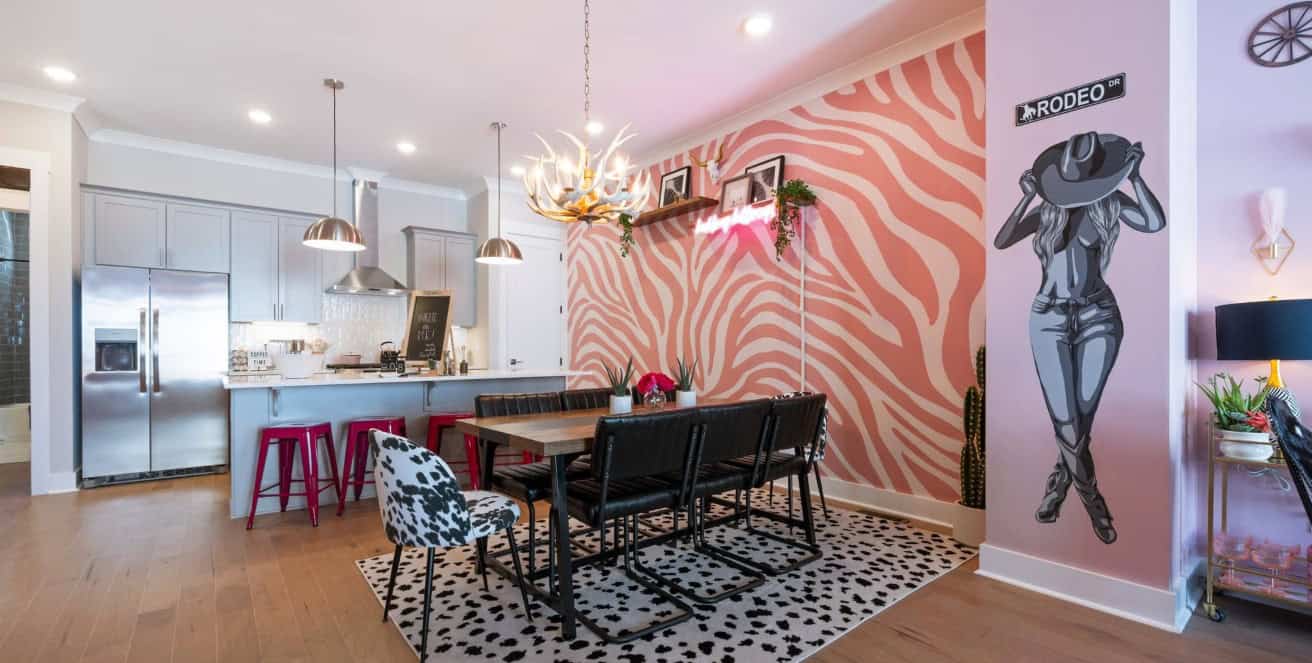The Complete Dinner Party Guide: How to Plan, Host & Create a Memorable Evening
- Date: April 22, 2025
- Topic: Parties
- Contributors: Written by Nina Gunther-SegalEdited by Alexis Shiraki

Source: Peerspace
Planning a dinner party can feel like a high stakes juggling act, especially if you’re doing it for the first time. As a dinner party host, you’ll need to be able to gracefully balance the art of entertaining with the art of cooking, not to mention the logistics of event planning!
If you’re moving beyond pizza nights and casual potlucks to plan a more “grown-up” gathering like a dinner party, you might be excited, but perhaps also overwhelmed. How can you create a polished and memorable night without spending the whole time stuck in the kitchen or trying to fill awkward silences between courses?
Our guide is here to help you step confidently into the role of planner and host. Outlining the timeline of how to plan a dinner party as well as diving into key elements of dinner party planning, from the menu to the tablescapes, we offer practical and detailed advice for planning and executing a totally seamless evening without losing your cool.
This guide is set apart by its real-world approach—it’s designed specifically for aspiring hosts navigating their first dinner party, which is why we’ve included our top solutions to the most common challenges associated with these kinds of events.
Now, let’s turn your vision of your dream dinner party into a night worth remembering!
Table of Contents:
- Complete Planning Timeline
- How to Create a Memorable Dinner Party
- Common Dinner Party Problems
- Dealing with Unique Dinner Party Situations
The Complete Timeline: Planning Guide

Beginning two weeks in advance of the event itself, here’s our step-by-step timeline for how to organize a dinner party:
2 Weeks Before: Foundation Phase
This is your time for building a solid “base” for the rest of your planning process—hence the use of the term “foundation.”
Once you’ve finalized your guest list (here’s more in-depth advice on how to put together a dinner party guest list) and sent out invitations, think about how your desired menu will suit the group. Consider factors like dietary restrictions as well as food preferences and the tone of the evening. Will you serve a plated dinner or use more casual family-style service?
As the menu shapes up, assess the space you’ll be using, whether that involves renting a venue or simply sprucing up your home dining room. Consider where people will sit, where you’ll serve drinks, and whether you’ll need to rearrange any furniture or rent/borrow extra tables and chairs.
If you’ll be doing the cooking yourself, create a rough grocery list. In addition, review your tableware and kitchen equipment. Will you have enough plates and glassware, or a large enough roasting pan?
This is the point at which you want to be figuring out all these details—definitely not the night before or the morning of!
1 Week Before: Key Decisions Phase
With a week to go, you should be confirming some key creative and logistical choices. Confirm RSVPs from the guests you invited the week before, and test out any new or tricky recipes to make sure there are no major surprises for the party itself.
Think about drinks, too—will you prepare a batch of cocktails, offer wine pairings, or keep it simple with sparkling water and juice? In addition, design your table setting (more on that in this section).
Start planning your playlist and figure out where the music will come from, assessing whether you have the right equipment to play it.
3 Days Before: Details Phase
At this point, you should be putting all the logistical pieces into motion, and focusing on polish: small touches that elevate your guests’ experience of the evening without overwhelming you.
Get your grocery shopping done so you aren’t scrambling at the last minute, including wine or other beverages. Launder and iron table linens and napkins, if you’ll be using them, and finalize your playlist.
Finally, check in with guests and confirm any changes to the headcount so you’re prepared for the number of people in attendance on the day of.
Day Before: Preparation Phase
The day before your dinner party is absolutely key to everything coming together.
Begin with initial food prep, such as chopping vegetables, marinating meat or fish, baking desserts, or making anything that will last well overnight.
If possible, thoroughly clean the house or the venue where your dinner party will be held, and set up your bar area/drink station. Last but not least, review your timing for the day of the party, including when various dishes go into the oven, when guests will arrive, and other milestones.
The more you can prepare in advance, the easier it will be to focus on your hosting duties when your guests finally arrive.
Visit Peerspace to discover dinner party venues that’ll take your gathering to the next level.
Deep Dive: What Every Memorable Dinner Party Needs

From here, let’s dive into the most important aspects of how to host a dinner party, from thoughtfully planning out the menu to carefully preparing the space for guests.
Menu Planning
Although delicious food is essential for a truly great dinner party, other elements also come into play here—pacing and balance being two of the most important.
When you begin planning the menu for your party, the first thing you should do is decide how many courses you’ll serve, as well as how each course will flow into the next one. A classic choice is the three-course meal (appetizer, main, dessert), but you can also add additional courses, such as a cheese course.
Timing is crucial—you want to select dishes that won’t force you to stay near the stove as guests are mingling, so you can fulfill your hosting duties as much as your cooking duties. Here, make-ahead options are going to be a lifesaver, including sauces, desserts, and some main dishes.
Always take dietary restrictions into account, asking guests in advance and doing your best to offer inclusive food options without noticeably singling anyone out. In addition, do your best to match your menu to the tone of the evening and to the season. For example, light seafood might be perfect for spring or summer, while a beef stew would be a hearty choice for a winter dinner party.
Guest Experience
Successful dinner parties make guests feel welcome and at ease. To help your dinner party achieve this effect, you’ll want to start planning out who’s coming and how they’ll interact. If there will be a mix of different kinds of personalities and/or people who don’t know each other yet, icebreakers and conversational cues can keep the conversation flowing.
Beyond food, consider guests’ comfort. Is the seating comfortable enough for a long meal? Are the temperature and lighting comfortable and inviting? Is there a place to safely store guests’ coats, bags, and other possessions?
Space Preparation
The space where your party takes place is akin to the “stage” for your evening. That’s why preparing it with care and attention to detail is one of the most important ways to make your dinner party memorable.
Begin with the basics, making sure you have enough table space and seating for your entire guest list. If it suits your theme, you can get elaborate with the table settings, but you certainly don’t have to—the most important thing is that they’re clean, coordinated, and have the essentials like drinking glasses and napkins.
When it comes to style, having a cohesive color scheme can make things feel intentional without being overdone. In addition, make sure to arrange the room so guests can easily move between the table, any other gathering areas, and the restroom.
Pro Tip: Selecting the right venue also goes a long way toward cultivating the right atmosphere for your party. To find your ideal location, browse high-quality dinner party venues in your area on Peerspace.
Handling Common Dinner Party Problems
Even when you’ve mastered exactly how to arrange a dinner party, unexpected hurdles can still arise—so here’s how to handle some of the most common dinner party issues with grace.
Food Challenges
No matter how carefully you plan out your dinner party menu, things can still take a wrong turn in the kitchen—whether it’s a burnt sauce or a guest revealing an unexpected food allergy at the last minute.
If these kinds of problems do occur, the most important thing to do is to respond with calm and flexibility. Having a backup plan can certainly help with that, perhaps in the form of a pantry staple like pasta.
Also helpful is including several make-ahead items on your dinner party menu, which means one less thing possibly going wrong during the party itself.
If the food is delayed, keep your guests happy with an extra round of appetizers. Hungry guests are unhappy guests, after all!
Finally, don’t over-apologize for mistakes. All that does is draw excess attention to things your guests might not even have noticed. If they do notice them, they’re sure to appreciate your calm, confident resolution of the problem.
Instead of trying to execute every aspect of the party flawlessly, set the tone with a gracious attitude and respond to last-minute hurdles by pivoting as best you can.
Conversation Lulls
Great dinner parties are defined by lively and engaging conversation, but even the most extroverted groups can hit occasional quiet patches. The solution to these instances is to facilitate things gently without oversteering the conversation.
You can head off these conversation lulls at the pass by planning out guest seating strategically. Place your more outgoing guests next to quieter ones, and make sure to spread familiar faces throughout the table so that no one guest feels particularly isolated.
Be a prepared host by having some thoughtful conversation starters ready if things start getting too quiet. These can just be open-ended questions like “What’s something new you’ve tried recently?”
It depends on your crowd, but we’d generally recommend avoiding diving into polarizing topics to avoid conflict. If the lull is lingering despite your best efforts to spur conversation, try a shift like serving the next course or changing up the musical playlist.
Guest Dynamics
Dealing with guest dynamics can be a total breeze, or it can be one of the most challenging parts of hosting, depending on who’s attending your dinner party. If personalities clash or guests’ energy levels vary considerably, this can create awkward situations or even conflict.
To avoid this situation, curate your guest list as thoughtfully as possible, considering how different guests will interact if they end up sitting next to each other.
However, even with excellent planning, awkward moments can still arise. If someone dominates the conversation or veers into difficult conversational territory, as the host, it’s your job to gently steer the subject in a different direction. We recommend humor and redirection as the best, least intrusive solution—something like, “Let’s save that debate for dessert, and in the meantime, does anyone have any upcoming vacation plans?”
If you notice that a guest seems uncomfortable or withdrawn, check in with them subtly. For more serious interpersonal conflict, create small breaks in the flow of the evening (such as a group toast or a shift to dessert in another room) to relieve the tension without drawing attention to it.
Ultimately, as the party’s host, your energy sets the tone for the evening. If you can stay relaxed and attentive, your guests are likely to follow your lead.
Unique Dinner Party Situations

Every dinner party has its own unique flavor. The event is a combination of everything from its level of formality (a refined multi-course affair or a laid-back and spontaneous gathering) to the location where it takes place (indoors in a fancy dining room or outdoors in a beautiful garden). And of course, the menu itself. Here’s some more advice geared toward these unique iterations of dinner party planning:
Formal Dinners
Although formal dinner parties create higher expectations among your guests, they’re also an opportunity to truly impress. These kinds of events typically involve fancy table settings, numerous courses, and a structured flow.
Plan a well-rounded menu that contains plenty of variety without making prep unnecessarily complicated. Courses can include an amuse-bouche, appetizer, main, palate cleanser, dessert, and cheese/coffee, among others.
Time management will be particularly important at such a structured event, so we’d recommend working backwards from your ideal serving times, building your prep schedule accordingly.
To cultivate the formal ambiance you’re seeking, use real linens, candles (if your venue allows them), proper place settings, and appropriate background music. Consider offering guests a printed menu as an extra bit of polish.
Casual Gatherings
Casual dinner parties tend to feel more relaxed, which means they often require less planning—but they do still require some thoughtful consideration.
These kinds of gatherings are ideal for shared dishes, buffet-style meals, and one-pot main dishes that make it easy for the host to stay present with guests instead of spending hours in the kitchen. Instead of fuss, the focus is the comfort of both you and your guests.
Feel free to skip the place cards, but make sure you have enough seating for everyone, and you can use candles or string lights to soften the lighting. In addition, if guests offer to bring a dish, say yes! Letting them contribute appetizers, drinks, or desserts can reduce your workload.
Flexible pacing keeps these kinds of casual evenings flowing, allowing guests to arrive and eat freely with no pressure to maintain a strict schedule. You can also incorporate games or other activities to keep things fun and engaging for guests.
Themed Evenings
A themed dinner party can be a creative and unforgettable experience, but it will require a little more planning than your average dinner party.
We’d suggest choosing a theme that’s broad enough to provide inspiration and cohesion, but still not so specific that it becomes difficult to adhere to and a source of stress. For instance, “retro dinner” is specific enough to help you start cultivating a certain vibe and aesthetic, but not so narrow that it’s tough to follow.
Once you’ve chosen your theme, build the meal around it, from the drinks to the dessert. Your themed decor can be elaborate, if desired, but it doesn’t have to be—with a few curated items, cohesive color choices, and music that suits the vibe, your dinner party venue or other hosting space will be transformed.
You might want to incorporate costumes or a dress code to keep guests truly on theme. If so, give them plenty of notice (we recommend mentioning it in your party invitations), so they feel prepared rather than pressured. Games, trivia, and other activities can also help spark conversation while helping to further cultivate the theme.
Wine Pairing
Carefully pairing the right wines with your dinner party menu is one of the best ways to add elegance to your dinner party and elevate your guests’ experience in the process. As intimidating as wine pairing might sound to those who’ve never done it before, it’s not reserved for the experts!
Wine pairing focuses on enhancing the flavors of both the food and the wine, mutually, so that each element shines more brightly than it would alone. As a rule of thumb, you want to match the “weight” of the wine to the richness of the accompanying dish—light wines go best with light dishes, and bolder wines work well with hearty and rich foods.
For instance, you could pair seafood or goat cheese salad with a crisp Sauvignon Blanc. For red meat or a robust stew, consider pouring your guests a rich Cabernet Sauvignon. Spicy foods like Indian or Thai food benefit from the addition of an off-dry Riesling or a chilled sparkling wine, countering their heat with some sweetness and refreshing acidity.
You also don’t need to provide a new wine pairing with every single course. Instead, you can choose one white and one red option that pair well with a variety of dishes.
To make it even more fun for your guests, consider including a brief description of each wine that you serve on a small menu card, so they can learn about the type of wine they’re imbibing—an educational and fun dinner party activity.
Planning a Dinner Party: Conclusion

Regardless of what kind of dinner party you decide to host, you’re sure to have a blast if you prepare thoughtfully and enjoy the process alongside your guests!
Throughout the planning process, don’t forget that the most memorable evenings aren’t the most impeccably planned out and free from any mistakes—they’re the ones where people feel connected and cared for. (Hopefully, that reminder takes a bit of the pressure of perfection off your shoulders.)
The key takeaways from this article are to:
- Plan ahead
- Know your guest list
- Create a welcoming environment
- Stay flexible in the face of unexpected hurdles
Even if something at your party ends up going off-script, if you’re a poised and upbeat host, it will guide the overall mood of the gathering.
In terms of next steps, begin reflecting on the type of dinner party that you’re most excited about hosting, and then start building your plan. Beginning at least two weeks before your planned party date with our timeline’s Foundation Phase, you’re giving yourself the best possible chance of planning a successful dinner party.
Whether you’re polishing silverware for a highly formal meal or gathering mismatched plates for a cozy night in with friends, the essentials for a great dinner party are the same: great food and great company.
Ready to start planning the dinner party of your dreams? Head to Peerspace to discover your perfect dinner party space.
Get together somewhere better
Book thousands of unique spaces directly from local hosts.
Explore SpacesShare your space and start earning
Join thousands of hosts renting their space for meetings, events, and photo shoots.
List Your Space





